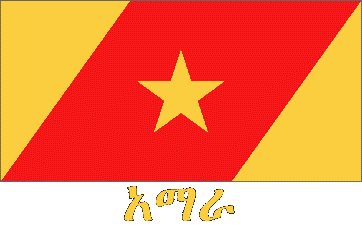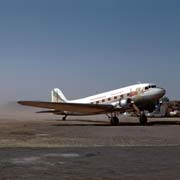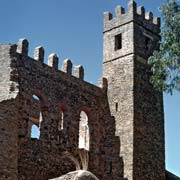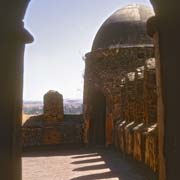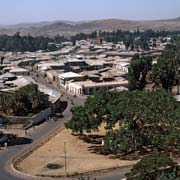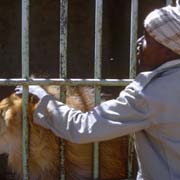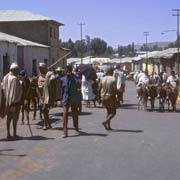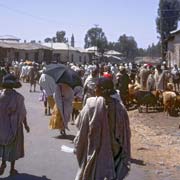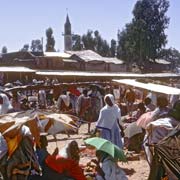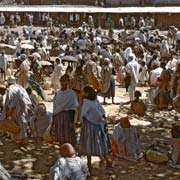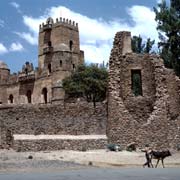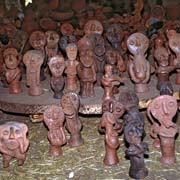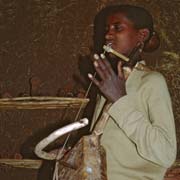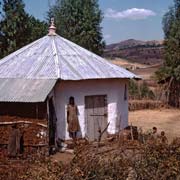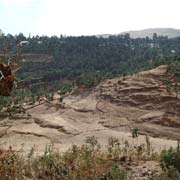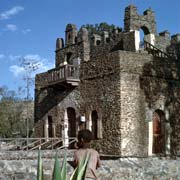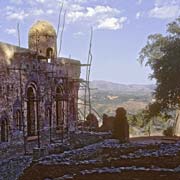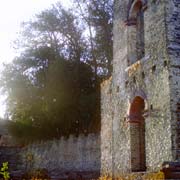Photos of Gondar, Ethiopia’s first Capital, Ethiopia
Gondar, Ethiopia’s first Capital
In the northwest of Ethiopia, Gondar is in the heart of the Amhara National Regional State; its flag is shown at top left). Gondar lies at 2,300 metres on a basaltic ridge from which streams, flanking the town, flow to Lake Tana, on the Blue Nile, 34 kilometres to the south. The city has almost 200,000 inhabitants and used to be the capital of Begemder province before the overthrow of the monarchy. It was founded by Emperor Fasilides in 1636 and was Ethiopia’s capital until 1855.
you may then send it as a postcard if you wish.
In Gondar, many remains of castles and palaces can be found; a series of emperors constructed these, from Fasilides (who reigned from 1632 to 1667) to Iyasu II (1730 - 1755). The ruins of these structures stand within a walled imperial enclosure. The most important buildings are the castle of Fasilides and the palace of Iyasu the Great, the emperor who reigned from 1682 to 1706. Only a few of the 44 churches in Gondar from the 18th Century survive. However, the city is still an important centre of the Ethiopian Orthodox Church: the beautiful Debre Berhan Selassie Church, dating from the 17th Century, is still used.
Gondar suffered greatly during the civil wars (1750 - 1890) in Ethiopia, but after the British conquest of the Sudan in 1899, the town resumed its trade with the Blue Nile region. The city’s inhabitants are mainly Christians, but some Muslims live in the locality, in the Addis Alem neighbourhood. The town is a trade centre for grains, oilseeds and cattle, but most people in the region around the city are subsistence farmers. The city is a significant highway junction and is served by an airport. There is a modern hospital with an attached medical university where staff for rural clinics are trained. Crafts from Gonder include textiles, jewellery, copperware and leatherwork.
Until the 1980s, a group of Ethiopian Jews, known as Beta Israel (“House of Israel”), lived in the region north of Lake Tana, near Gonder. They lived in separate villages or in separate quarters in Christian or Muslim towns and were generally referred to as “Falasha”, an Amharic word meaning “exiles”. Falasha tradition claims to trace their ancestry to Menelik, son of King Solomon of Israel and the queen of Sheba. Their origin can probably be dated before the Second Century BCE because they were unfamiliar with the Talmud and instead used the Bible, written in ancient Ge’ez. They practised a modified form of Mosaic Judaism and had retained animal sacrifice. During the famine and political instability in late 1984 and early 1985, thousands of Ethiopian Jews were airlifted to Israel from refugee camps in Sudan as part of the Israeli government’s “Operation Moses” and the US government’s “Operation Sheba”. More than 12,000 Falashas had been airlifted to Israel in late 1984 and early 1985 when the Ethiopian regime halted the program. The airlift resumed in 1989, and about 3,500 Falashas emigrated to Israel in 1990. Nearly all of the more than 14,000 Falashas remaining in Ethiopia were evacuated by the Israeli government in May 1991. By the end of 1999, virtually all the Falasha practising Jews had been flown to Israel.
